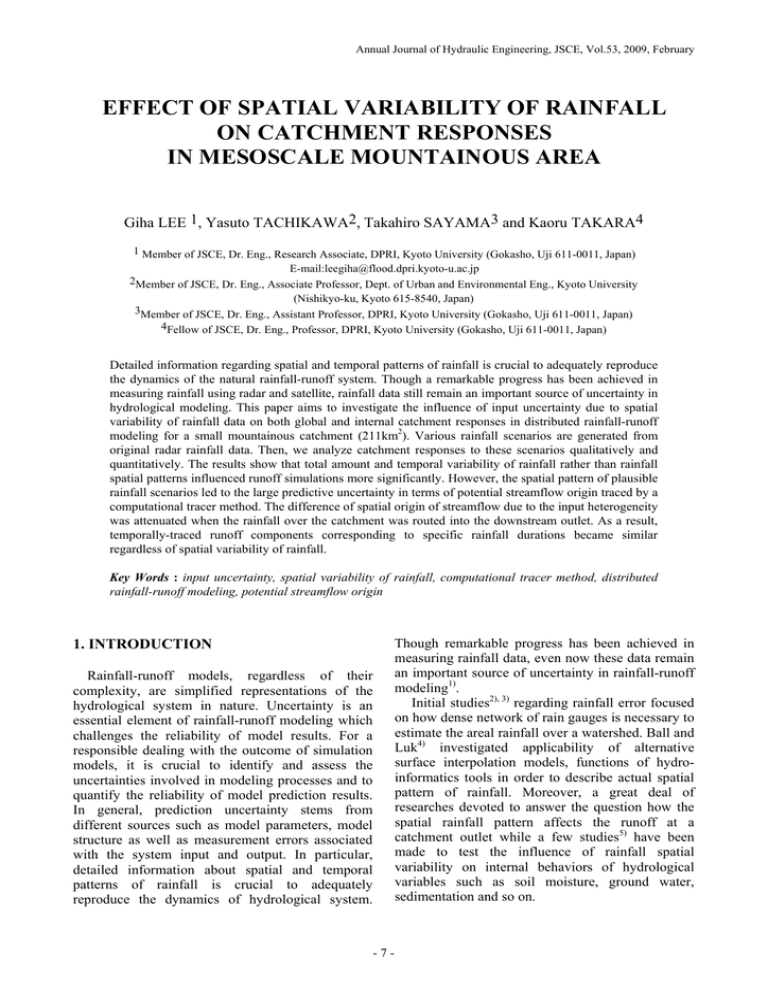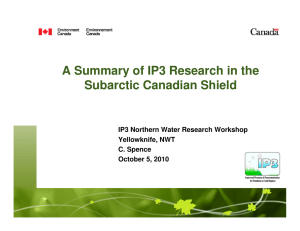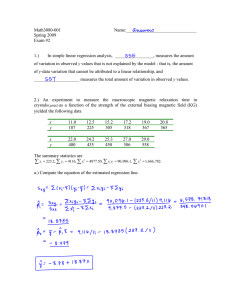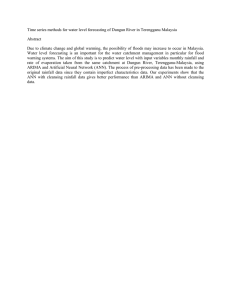EFFECT OF SPATIAL VARIABILITY OF RAINFALL ON CATCHMENT RESPONSES
advertisement

Annual Journal of Hydraulic Engineering, JSCE, Vol.53, 2009, February Annual Journal of Hydraulic Engineering, JSCE, Vol.53, 2009, February EFFECT OF SPATIAL VARIABILITY OF RAINFALL ON CATCHMENT RESPONSES IN MESOSCALE MOUNTAINOUS AREA Giha LEE 1, Yasuto TACHIKAWA2, Takahiro SAYAMA3 and Kaoru TAKARA4 1 Member of JSCE, Dr. Eng., Research Associate, DPRI, Kyoto University (Gokasho, Uji 611-0011, Japan) E-mail:leegiha@flood.dpri.kyoto-u.ac.jp 2Member of JSCE, Dr. Eng., Associate Professor, Dept. of Urban and Environmental Eng., Kyoto University (Nishikyo-ku, Kyoto 615-8540, Japan) 3Member of JSCE, Dr. Eng., Assistant Professor, DPRI, Kyoto University (Gokasho, Uji 611-0011, Japan) 4Fellow of JSCE, Dr. Eng., Professor, DPRI, Kyoto University (Gokasho, Uji 611-0011, Japan) Detailed information regarding spatial and temporal patterns of rainfall is crucial to adequately reproduce the dynamics of the natural rainfall-runoff system. Though a remarkable progress has been achieved in measuring rainfall using radar and satellite, rainfall data still remain an important source of uncertainty in hydrological modeling. This paper aims to investigate the influence of input uncertainty due to spatial variability of rainfall data on both global and internal catchment responses in distributed rainfall-runoff modeling for a small mountainous catchment (211km2). Various rainfall scenarios are generated from original radar rainfall data. Then, we analyze catchment responses to these scenarios qualitatively and quantitatively. The results show that total amount and temporal variability of rainfall rather than rainfall spatial patterns influenced runoff simulations more significantly. However, the spatial pattern of plausible rainfall scenarios led to the large predictive uncertainty in terms of potential streamflow origin traced by a computational tracer method. The difference of spatial origin of streamflow due to the input heterogeneity was attenuated when the rainfall over the catchment was routed into the downstream outlet. As a result, temporally-traced runoff components corresponding to specific rainfall durations became similar regardless of spatial variability of rainfall. Key Words : input uncertainty, spatial variability of rainfall, computational tracer method, distributed rainfall-runoff modeling, potential streamflow origin Though remarkable progress has been achieved in measuring rainfall data, even now these data remain an important source of uncertainty in rainfall-runoff modeling1). Initial studies2), 3) regarding rainfall error focused on how dense network of rain gauges is necessary to estimate the areal rainfall over a watershed. Ball and Luk4) investigated applicability of alternative surface interpolation models, functions of hydroinformatics tools in order to describe actual spatial pattern of rainfall. Moreover, a great deal of researches devoted to answer the question how the spatial rainfall pattern affects the runoff at a catchment outlet while a few studies5) have been made to test the influence of rainfall spatial variability on internal behaviors of hydrological variables such as soil moisture, ground water, sedimentation and so on. 1. INTRODUCTION Rainfall-runoff models, regardless of their complexity, are simplified representations of the hydrological system in nature. Uncertainty is an essential element of rainfall-runoff modeling which challenges the reliability of model results. For a responsible dealing with the outcome of simulation models, it is crucial to identify and assess the uncertainties involved in modeling processes and to quantify the reliability of model prediction results. In general, prediction uncertainty stems from different sources such as model parameters, model structure as well as measurement errors associated with the system input and output. In particular, detailed information about spatial and temporal patterns of rainfall is crucial to adequately reproduce the dynamics of hydrological system. -7- Fig. 1 Spatial patterns of accumulated rainfall and comparison of areal mean rainfall between original radar data (i.e., Scenario 1) and the generated scenarios (i.e., Scenarios 2 ~ 8). The main objective of this study is to assess the impact of input uncertainty due to spatial variability of rainfall on catchment responses, which are not only discharge but also potential streamflow origin, in distributed rainfall-runoff modeling. The key research question that this study addresses is: how does input uncertainty based on various rainfall scenarios, which are generated from observed radar rainfall data, influence model simulations for (a) hydrograph and (b) spatiotemporal origin of streamflow at the outlet of the study site. rearranged rainfall field of Scenario 6. Scenario 8 changes the origin of the original radar data (i.e., Scenario 1) based on X and Y axes in order to clarify the influence of the rainfall spatial pattern due to relocation of rainfall cells, on catchment responses. Fig. 1 shows the spatial distributions of the total rainfall depths of eight rainfall scenarios and the comparison of areal mean rainfall between original radar data of Scenario1 (hereafter, S1) and the generated rainfall scenarios (i.e., S2,…,S8). 2. VARIOUS RAINFALL SCENARIOS 3. RAINFALL-RUNOFF MODEL Radar rainfall data (the Ejiroyama X-band radar) with 1km spatial resolution is available for the study site, the Kamishiiba catchment (211km2). A historical flood event by Typhoon No. 9 (15-19 September 1997) is used to generate various spatial patterns of the original rainfall data. Five grid cells are selected from the observed radar rainfall field and then they are assumed as virtual gauge stations representing the rainfall characteristics of downstream (gauge 1), mid-stream (gauge 2), and upstream (gauge 3, 4, and 5) in the study area. Five synthetic rainfall fields are generated based on the chosen virtual stations using the nearest neighborhood interpolation method in the order of the number of gauges used in interpolation; from Scenario 2 to Scenario 6. Rain gauges of Scenario 7 are rearranged randomly to examine the effect of spatial variability of rain gauges on runoff simulation. Namely, Scenario 7 indicates the The Kinematic Wave Method for Subsurface and Surface Runoff (KWMSS)6) is based on onedimensional kinematic wave flow routing and has inherent capabilities for catchment partitioning, sub-catchment modeling, sub-catchment linking, and channel network processing. In this model, the drainage network is represented by sets of slope and channel elements. The rainfall-runoff transformation conducted by the KWMSS is based on the assumption that each element is covered with a permeable soil layer, D as shown in Fig. 2. This soil layer consists of a capillary layer and a non-capillary layer. In these conceptual soil layers, water flow are simulated as unsaturated Darcy flow and saturated Darcy flow, and overland flow occurs if water depth, h exceeds soil water capacity. The KWMSS represents these runoff processes by the stage-discharge relationship7), defined as: -8- Fig. 2 Schematic model structure and extended stagedischarge relationship of KWMSS. ⎧vc d c (h / d c ) β , 0 ≤ h ≤ dc ⎪ q = ⎨vc d c + va (h − d c ), dc ≤ h ≤ ds ⎪v d + v (h − d ) + α (h − d ) m , d ≤ h c s s ⎩ c c a (1) ∂h ∂q + = r (t ) ∂t ∂x (2) Fig. 3 Relative errors of total depth of rainfall for each scenario. overestimated approximately 25% when comparing to S1. However, the other spatially-distributed scenarios lead to comparatively acceptable results in terms of total amount of rainfall in this catchment. All scenarios except for S2 do not exceed the relative error of ±5%. In particular, even though S3 is more spatially-aggregated than S4~S8, the relative error of S3 is smaller than S4~S7 and similar with S8. The relative errors of runoff simulations corresponding to these rainfall scenarios are summarized in Fig. 4. Note that REV, REP, and REPT indicate relative error of total runoff volume, relative error of peak discharge, and relative error of peak time, respectively. In spite of different spatial variability of rainfall in the generated scenarios, the runoff simulation results corresponding to S3~S8 are acceptable since relative errors of runoff properties are within ±10%. The difference of total rainfall depth due to rain gauge sampling as shown in Fig. 3 results in very similar error patterns with respect to REV and REP while REPT is less sensitive to the spatial patterns of rainfall scenarios used here. Even the peak time of S2 shows the relative errors of less than 10% but the errors of runoff volume and peak flow for this scenario are much deviated from S1. The results indicate that total amount and temporal variability of rainfall during the event period affect runoff simulation more significantly than the spatial pattern itself of rainfall in the study catchment. Flow rate, q of each slope segment is calculated by Eq.(1) combined with the continuity equation, Eq.(2), where vc = kc i ; va = kai ; k c = k a / β ; α = i / n ; m=5/3; i is slope gradient, k c is hydraulic conductivity of the capillary soil layer, k a is hydraulic conductivity of the non-capillary soil layer, n is roughness coefficient, the water depth corresponding to the water content is d s and the water depth corresponding to maximum water content in the capillary pore is d c . There are five parameters (n, k a , d s , d c and β ), which need to be optimized in KWMSS. This model is calibrated by only S1 rainfall data and this data is assumed to provide the best estimate of input to the model. Then, the calibrated model is applied to the study site represented by 500m Digital Elevation Model (DEM). 4. EFFECT OF INPUT UCERTATINTY ON HYDROGRAPH PROPERTIES For each rainfall scenario, we compute the relative errors in rainfall and catchment responses. The relative errors of rainfall and runoff simulation are computed as: RS1 − RSi (3) × 100 i = 2, LL ,8 RS1 where RS1 is either the accumulated depth of areal rainfall or the general properties of runoff based on S1 such as runoff volume, peak flow and timing of peak and RSi is the variable of interest in Scenario i. The relative errors of total amount of rainfall for all scenarios are illustrated in Fig. 3. This figure demonstrates that the most spatially uniform rainfall field, S2 fails to estimate accurate amounts of areal rainfall. The total rainfall of S2 is Fig. 4 Effect of rainfall error on runoff properties for each scenario. -9- In other words, spatially less distributed rainfall data can also be suited for rainfall-runoff simulations in this small mountainous catchment if the aggregated rainfall field by a few rain gauges captures a total volume of rainfall successfully during the event period. However, this result does not imply that scenarios with only several rain gauges optimally present the actual spatial variability of rainfall. Within the context of ‘equifinality’8) (i.e., indistinguishable runoff simulation results in spite of poor consideration of rainfall spatial variability), it may be worthwhile to find answers to the following questions: 1) how do internal responses of the catchment react to plausible rainfall scenarios (S3 and S8) containing very similar information with respect to the total amount and temporal variability?; and 2) if unlike equivalent hydrographs reproduced from the plausible input data, internal catchment responses are sensitive to spatial variability of rainfall, how can we demonstrate the prediction uncertainty due to input uncertainty? To account for the influence of plausible input data on the internal catchment response, we employ the computational tracer method9) capable of tracing potential streamflow origin within the catchment. Then, we compare the prediction results between the original input, S1 and the plausible inputs, S3 and S8. 5. COMPUATIONAL TRACER METHOD AND RESULTS OF STREAMFLOW ORIGIN TO PLUASIBLE INPUTS The goal of the computational tracer method is to trace where streamflow comes from when it rains over the catchment. This method can show the potential streamflow origin in time and space by using a spatiotemporal record matrix as illustrated in Fig. 5. The dimension of matrix Ri (t ) is given with Ns (number of sub-units within catchment) rows and NT (number of temporal classes) columns where i is specific slope element; t is time. Fig. 5(c) shows the spatiotemporal matrix at time t at the catchment outlet. For example, the value belonging to spatial zone C and temporal class 2 implies that the contribution of (C,2) entry to the outlet streamflow observation at time t is 6%. When summarizing the whole values vertically along the columns, the temporal contribution of rainfall to streamflow can be obtained. Likewise, the spatial contribution of sub-catchments on streamflow is calculated by horizontal summation along the rows. As a result, modelers can divide into two runoff components; old water (i.e., pre-event water at time Fig. 5 Schematic diagram of the computational tracer method based on (a) temporal record of streamflow, (b) spatial record of streamflow and (c) spatiotemporal record matrix of streamflow; Ns=6, NT=5. class 0 possesses 15%) and new water (i.e., new water components are 30% at time class 1 and 55% at time class 2, respectively) at the specific time t. Moreover, it is possible to track the spatially-distributed origin for runoff generation using this matrix with information stored in each slope element, for instance, downstream spatial zones (e.g., D, E, and F) contribute more than 60% of streamflow whereas upstream zones (e.g., A, B, and C) affect runoff generation less at time t. More details about this conceptual matrix are presented in Sayama et al.9). The drainage network of the Kamishiiba catchment is represented by 860 slope elements (Ns =860) of 500m DEM. Each slope element is regarded as the potential origin of streamflow. The spatiotemporal matrix is updated every 1 hour time step during the model simulation. The contribution of each slope element to runoff generation at the specific time step is represented by Relative Ratio of Total Discharge (RRTD) at the outlet, defined as: Di (t ) RRTDi (t ) = outlet × 100 (%) D (t ) (4) Ns ∑ RRTD (t ) = 100 i (%) i =1 where i is slope element number; Ns is total number of slope elements; Di (t ) is discharge at the outlet from slope element i within the catchment at time t; D outlet (t ) is total discharge of the outlet at time t. Four particular time steps, 1, 12, 36 and 72 hours are selected in order to visualize the spatial origin of the runoff for S1 and then the results are compared with the results produced from the plausible - 10 - Fig. 7 Variation of the Contributing Percentage (CP) of each sub-catchment due to the three rainfall scenarios. Fig. 6 Effect of input uncertainty due to spatial variability of rainfall on internal catchment response: spatially distributed origins of streamflow for S1, S3, and S8. rainfall scenarios, S3 and S8. Each RRTD for the selected four time steps is plotted with seven classes as shown in Fig. 6. At the beginning of rainfall-runoff process, the adjacent slope elements to river channel, which is referred to as riparian zone, constitute primarily of the streamflow while the water stored in upstream slope elements do not reach the river channel yet. As time goes on, contributive areas spread gradually over the catchment and eventually, all slope elements contribute for the streamflow generation. An interesting finding is that even though runoff simulation properties at the outlet for S1, S3, and S8 are identical (see Fig. 4), the distributions of streamflow origin are different in space according to the spatial pattern of rainfall data. To quantify the variation of spatial distribution of streamflow origin at sub-catchment scale, a simple index, Contributing Percentage of the sub-catchment (CP) is proposed as follows: CPj (t ) = ∑ RRTD j (t ) i∈ j 8 ∑ CP (t ) = 100 j =1 j (%) (5) where j is the sub-catchment number; the study catchment is divided into eight sub-catchments as shown in the left-top panel of Fig. 6 and then the contribution of each sub-catchment to streamflow generation is calculated. Fig. 7 shows the results of CPs for the three scenarios. The results clearly show that the different spatial patterns of plausible rainfall scenarios from the original rainfall pattern lead to the significant predictive uncertainty in terms of potential streamflow origin unlike their equivalent runoff properties. At the 1 hour time step, the patterns of CP are too much different while the variations of CP become gradually similar after the peak time (36 hours) of the event. It means that after stopping rainfall, S3 and S8 also result in nearly identical CP values regardless of their different spatial patterns. Furthermore, the historical event is split into six temporal classes (i.e., NT=6: pre-event, 0~15hrs, 16~22hrs, 23~30hrs, 31~34hrs and 35~84hrs) and then the simulated hydrographs based on S1, S3, and S8 are separated into six corresponding runoff components to each rainfall duration by using the temporal matrix of streamflow record. Fig. 8 illustrates the results under the original and plausible scenarios, which are temporally-separated hydrographs with respect to selected rainfall durations. In this figure, the volume of all runoff components including both pre-event water and event water did not change according to the spatial pattern of rainfall. It corroborates that even if the spatial patterns of S3 and S8 are different from S1, the temporal variations of streamflow origin are very similar because their total rainfall depth over the catchment are similar during the study event period and the best-performing parameter set of the original data is applicable for runoff modeling based on the plausible input scenarios. Also, it can be concluded that the KWMSS can lead to multiple alternative flow pathways, yielding very similar - 11 - hydrographs due to plausible input data. In other words, the effect of rainfall spatial pattern on spatially- distributed streamflow origin is gradually smoothen or weakened as the rainfall over the catchment drains into the downstream outlet in form of either surface/subsurface flow or a mixture of both. The different CP values in Fig. 7 indicate that the different distributions of spatial streamflow origin can exist due to rainfall spatial patterns but the different CP values do not influence temporal streamflow observations as shown in Fig. 8. As a result, temporally-traced runoff components corresponding to specific rainfall durations became similar regardless of spatial variability of rainfall. 6. CONCLUSIONS This paper aimed to investigate the effect of input uncertainty due to spatial variability of rainfall data on runoff simulation and potential origin of streamflow by using the distributed rainfall-runoff model, KWMSS and the computational tracer method. The following observations with respect to input uncertainty to catchment responses were made: Fig. 8 Temporally-separated runoff components corresponding to the six rainfall durations for the three rainfall scenarios. 1) even less spatially-distributed rainfall scenarios (e.g., S3, S6 and S7) than the original data could provide acceptable runoff simulation results. It backs up that temporal variability and amount of rainfall were more important than the spatial pattern itself of rainfall data in rainfall-runoff modeling for the small mountainous catchment; 2) the spatial patterns of plausible rainfall scenarios, which led to similar runoff properties with the original rainfall data, resulted in significant predictive uncertainty in terms of spatial distribution of streamflow origin, traced by the computational tracer method; 3) even if the spatial variability of rainfall was different, the aggregated catchment output, temporally-separated runoff component has no difference as the rainfall over the study catchment was routed into the downstream outlet through the drainage network that was represented by a number of slope elements. In future works, we will clarify the importance of spatial variability of rainfall by applying the proposed methodology to various catchments containing different characteristics. REFERENCES 1) O’Connell, P.E. and Todini, E.: Modeling of rainfall, flow and mass transport in hydrological systems: an overview, Journal of Hydrology 175, pp.3-16, 1996. 2) Dawdy, D.R. and Bergmann, J.M.: Effect of rainfall variability on streamflow simulation, Water Resources Research 5(5), 958-966, 1969. 3) Hamlin, M.J.: The significance of rainfall in the study of hydrological processes at basin scale, Journal of Hydrology 65, 73-94, 1993. 4) Ball, J.E. and Luk, K.C.: Modeling spatial variability of rainfall over a catchment, Journal of Hydrologic Engineering 3(2), pp.122-130, 1998. 5) Shuurmans, J.M. and Bierkens, M.F.P: Effect of spatial distribution of daily rainfall on interior catchment response of a distributed hydrological model, Hydrology and Earth System Science 11, 677-693, 2007. 6) Ichikawa, Y., Shiiba, M., Tachikawa, Y. and Takara, K.: Object-oriented hydrological modeling system, Proc. of 4th International Conference Hydro-informatics, CD-ROM, Iowa, USA, 2000. 7) Tachikawa, Y., Nagatani, G. and Takara, K.: Development of stage-discharge relationship equation incorporating saturated–unsaturated flow mechanism, Annual Journal of Hydraulic Engineering 48, pp.7-12, 2004 (in Japanese). 8) Beven, K.: A manifesto for the equifinality thesis, Journal of Hydrology 320 (1-2), pp.18-36, 2006. 9) Sayama, T., Tatsumi, K., Tachikawa, Y. and Takara, K.: Hydrograph separation based on spatiotemporal record of streamflow in a distributed rainfall-runoff model, Journal of Japan Society of Hydrology & Water Resources 20(3), pp.214-225, 2007 (in Japanese). (Received September 30, 2008) - 12 -




